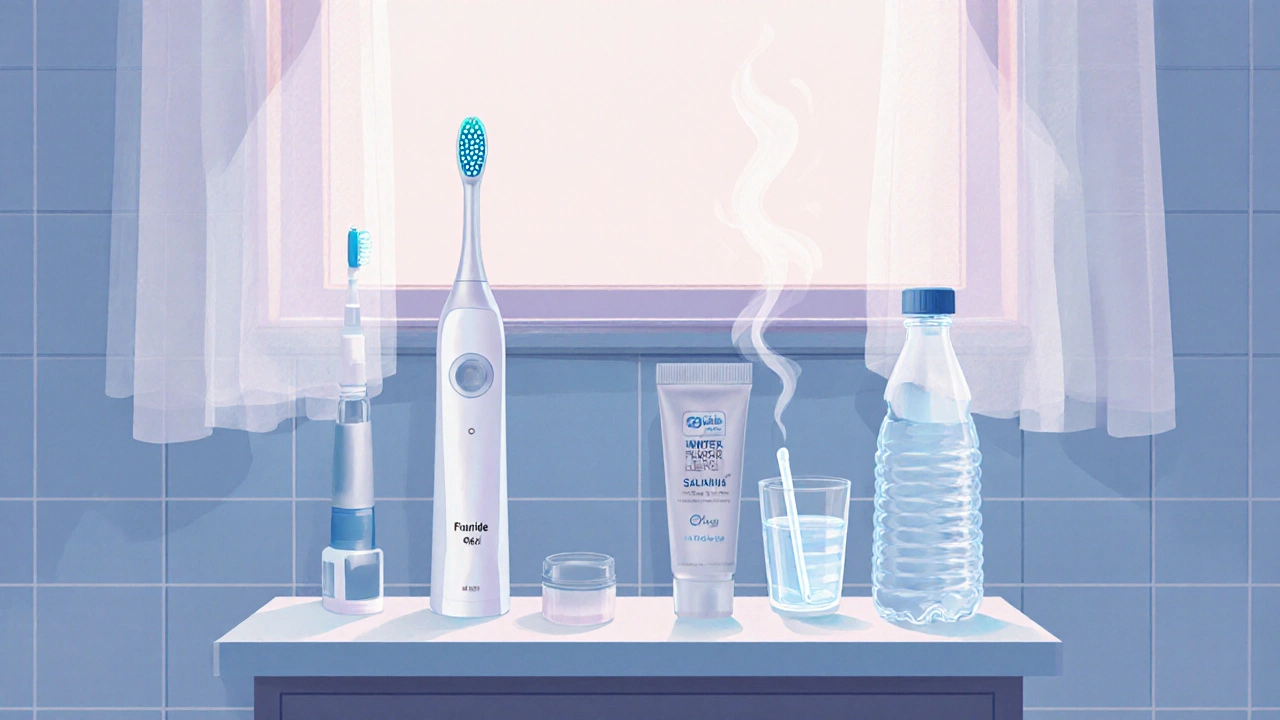Sickle Cell Anemia Dental Health Risk Checker
Assess Your Risk Level
Answer the following questions to determine your risk level for oral complications related to sickle cell anemia and get personalized dental care recommendations.
Your Dental Health Risk Assessment
Living with Sickle Cell Anemia is a daily balancing act-managing pain, staying hydrated, and keeping energy up. What many don’t realize is that the condition also puts the mouth at risk. That’s why mastering sickle cell anemia dental health isn’t just about a bright grin; it’s a real health safeguard.
Key Takeaways
- Sickle cell anemia can trigger mouth ulcers, dry mouth, and higher infection rates.
- Regular dental check‑ups, gentle brushing, and fluoride use cut down decay and gum disease.
- Coordinating care between your hematologist and dentist prevents emergencies during a vaso‑occlusive crisis.
- Hydroxyurea and other meds may affect oral tissues-know the side‑effects.
- A simple daily checklist keeps your smile safe without overwhelming your routine.
How Sickle Cell Anemia Affects the Mouth
When Sickle Cell Anemia forces red blood cells into a rigid shape, they can block tiny blood vessels. In the gums and oral mucosa, reduced blood flow means less oxygen and nutrients, leading to painful lesions and slower healing.
Three common oral issues pop up more often in patients:
- Mouth ulcers - tiny, painful sores that linger because the tissue can’t get enough blood.
- Dry mouth - many sickle‑cell meds lower saliva, and saliva is the mouth’s natural cleanser.
- Increased infection risk - a weakened immune system means gingivitis can turn into periodontitis faster.
Understanding these risks sets the stage for a proactive dental plan.
Common Dental Problems in Sickle Cell Patients
Below is a quick snapshot of the oral conditions you’re most likely to encounter and why they matter.
| Condition | Primary Trigger | Potential Complication |
|---|---|---|
| Mouth Ulcers | Ischemia from vaso‑occlusive episodes | Secondary bacterial infection |
| Dental Caries | Dry mouth + sugary fluids for hydration | Tooth loss, pain, eating difficulties |
| Periodontal Disease | Reduced immune response + plaque buildup | Bone loss, systemic inflammation |

Why Regular Dental Visits Are Non‑Negotiable
Most dentists recommend a six‑month check‑up. For sickle‑cell patients, bump that to every three to four months during high‑risk periods (e.g., after a transfusion or when starting a new drug).
During a visit, the dentist can:
- Spot early decay before it becomes a painful cavity.
- Assess gum health and intervene before periodontitis spreads.
- Provide fluoride varnish or antimicrobial rinses tailored to low‑saliva conditions.
- Coordinate with your hematologist about timing-scheduling cleanings between crisis episodes reduces stress.
Building a Sickle‑Cell‑Friendly Oral Hygiene Routine
Good oral hygiene doesn’t have to be a marathon. A short, consistent routine works best when energy levels fluctuate.
- Choose the right brush: A soft‑bristled electric toothbrush (Oral Hygiene tool) gently removes plaque without irritating fragile gums.
- Fluoride toothpaste: Look for at least 1450ppm fluoride. It strengthens enamel, which is crucial when dry mouth lowers natural remineralization.
- Mindful flossing: If traditional floss hurts, switch to a water flosser to clean between teeth without pressure.
- Stay hydrated with low‑sugar fluids: Sip water throughout the day; avoid citrus juices that can erode enamel.
- Saliva substitutes: Over‑the‑counter mouth moisturizers (xylitol‑based) keep the mouth moist and fight cavity‑causing bacteria.
Stick to this sequence twice daily. Even on “off” days, a quick 30‑second brush before bed is better than skipping.
Medication Effects on Your Mouth
Two common treatments for sickle‑cell complications can influence oral health.
- Hydroxyurea - reduces painful crises but may cause dry mouth and occasional mucosal irritation.
- Blood transfusions - while lifesaving, they can increase iron levels, which over time may affect gum health.
If you notice new ulcers or a gritty feeling after starting or changing dosage, alert both your dentist and hematologist. Adjusting dosage or adding a saliva stimulant can prevent bigger problems.

Handling Dental Emergencies During a Crisis
A sudden toothache or a burst abscess during a vaso‑occlusive episode (Vaso‑occlusive Crisis) can feel overwhelming. Here’s a rapid response plan:
- Pause any activity and hydrate with small sips of water.
- Apply a cold compress to the cheek to reduce swelling.
- If pain is severe, take the prescribed analgesic (often ibuprofen, unless contraindicated).
- Contact your dentist’s emergency line-many practices have on‑call providers for sickle‑cell patients.
- If you can’t reach a dentist within 2hours, go to the nearest urgent‑care clinic; bring a copy of your hematology records.
Having this checklist on your fridge prevents panic and speeds up care.
Coordinating Care: Dentist Meets Hematologist
Effective oral health management hinges on communication. Ask your hematologist to send a short health summary to your dentist, including:
- Current medication list (especially Hydroxyurea dosage).
- Recent hemoglobin levels and any recent transfusions.
- History of vaso‑occlusive episodes in the past six months.
In return, request that your dentist notes any dental procedures that might trigger bleeding or infection. For invasive work (extractions, deep cleanings), timing it a week after a transfusion often gives the best blood count support.
Daily Checklist for a Healthy Smile
- Brush with fluoride toothpaste twice a day.
- Use a soft‑bristled electric brush or water flosser.
- Carry a saliva substitute for dry‑mouth moments.
- Drink water every hour; limit sugary drinks.
- Schedule dental appointments every 3‑4 months.
- Inform dentist of any new ulcers or unusual gum bleeding.
- Keep a copy of your latest blood work handy for dental visits.
Checking these items each evening turns oral care into a habit, not a chore.
Frequently Asked Questions
Why do people with sickle cell anemia get more mouth ulcers?
Mouth ulcers form when tiny blood vessels in the oral lining become blocked during a vaso‑occlusive crisis, depriving the tissue of oxygen. The reduced blood flow slows healing, so even small sores can linger and become painful.
Can fluoride treatments prevent cavities for someone with dry mouth?
Yes. Fluoride strengthens enamel and helps remineralize spots that would otherwise decay faster in a low‑saliva environment. Professional varnish applied every 3‑4 months is especially effective.
Is it safe to get a dental cleaning during a blood transfusion cycle?
Generally, yes. In fact, scheduling a cleaning a week after a transfusion gives a higher hemoglobin level, reducing bleeding risk. Always confirm the timing with both your hematologist and dentist.
What over‑the‑counter products help with dry mouth?
Look for saliva substitutes containing xylitol or carboxymethylcellulose. Products like Biotène mouthwash, OTC moisturizing gels, or sugar‑free chewing gum stimulate saliva without adding cavities.
Should I tell my dentist if I’m on Hydroxyurea?
Absolutely. Hydroxyurea can cause dry mouth and occasional mucosal irritation, which affects how the dentist plans cleaning methods and post‑procedure care.

 Oct, 5 2025
Oct, 5 2025

Ragha Vema
October 5, 2025 AT 13:55I'm pretty sure there's a whole shadow network of dental product companies that want us to ignore the real issue-our bodies fighting sickle cell crises. They sell fancy toothpaste while we’re juggling pain meds and dehydration. The guide mentions fluoride, but it never flags the hidden chemicals that could trigger a crisis. Keep an eye on the ingredient list, and don’t be shy about asking your dentist to double‑check any new product.
Scott Mcquain
October 6, 2025 AT 12:08It is incumbent upon us, as responsible members of the community, to recognize that proper oral hygiene is not merely a cosmetic concern, but a moral duty, especially for those battling sickle cell anemia; neglecting it borders on negligence, and the guide rightly emphasizes regular dental visits, fluoride use, and hydration, all of which are indispensable, undeniably.
kuldeep singh sandhu
October 7, 2025 AT 10:21Many readers will assume that more frequent dentist appointments automatically solve every problem, yet the reality is that over‑scheduling can increase stress during vaso‑occlusive episodes, so a balanced approach is preferable.
Mariah Dietzler
October 8, 2025 AT 08:35i think the guide is ok but kinda boring.
Nicola Strand
October 9, 2025 AT 06:48While the article correctly outlines standard preventive measures, it fails to address the socioeconomic barriers that prevent many sickle‑cell patients from accessing fluoride varnish or specialized care, a lapse that warrants serious consideration.
Jackie Zheng
October 10, 2025 AT 05:01One cannot overstate the importance of precise language when discussing medical protocols; the term “dry mouth” should be accompanied by its clinical synonym, xerostomia, to avoid ambiguity. Moreover, the recommendation to use a “soft‑bristled electric toothbrush” is sound, yet it would benefit from specifying a brush head size appropriate for compromised gingiva. Fluoride concentration, cited as “at least 1450 ppm,” aligns with the American Dental Association’s guidelines, which adds credibility. Finally, the suggestion to coordinate appointments with a hematologist demonstrates interdisciplinary best practice. In sum, the guide merges practicality with evidence‑based advice.
Hariom Godhani
October 11, 2025 AT 03:15It is a grave injustice that the silent suffering of sickle‑cell patients is often eclipsed by the glitter of modern dentistry, for while we polish enamel, the very blood that sustains our gums is compromised. First, consider the physiological cascade: sickled erythrocytes obstruct capillaries, depriving oral tissues of oxygen, which precipitates ulcers that fester unnoticed. Second, the ubiquitous prescription of hydroxyurea, though life‑saving, introduces xerostomia, a condition that converts even the simplest morsel into a harbinger of decay. Third, the recommended fluoride toothpaste, while beneficial, may be insufficient without adjunctive saliva substitutes, especially when salivary flow drops below a critical threshold. Fourth, the guide urges three‑monthly dental visits, yet fails to acknowledge that many patients lack transportation or insurance coverage, turning this ideal into an unattainable luxury. Fifth, the emphasis on water flossers, though gentle, neglects the cost barrier that excludes low‑income families. Sixth, the notion that “hydration with low‑sugar fluids” is simple ignores cultural dietary practices that favor sweetened beverages, thereby perpetuating caries risk. Seventh, the article’s brief mention of iron overload from transfusions glosses over its impact on periodontal health, a gap that demands scrutiny. Eighth, coordinating care between hematologists and dentists, while sound, often falls apart due to fragmented medical records, leaving patients vulnerable during crises. Ninth, the checklist at the article’s end, though comprehensive, assumes daily cognitive bandwidth that many battling chronic pain simply do not possess. Tenth, the recommendation to avoid citrus juices discounts the nutritional value of vitamin C, which could be obtained through alternative sources. Eleventh, the guide’s silence on smoking cessation overlooks a potent exacerbator of oral disease in this population. Twelfth, the suggested use of xylitol‑based mouthwashes, while evidence‑based, may trigger gastrointestinal upset in some individuals, a nuance absent from the text. Thirteenth, the advice to schedule cleanings a week post‑transfusion, though logical, does not consider the variability of individual hemoglobin recovery curves. Fourteenth, the article fails to address the psychological toll of chronic oral discomfort, an aspect that intertwines with overall health outcomes. Fifteenth, the lack of patient‑authored narratives in the guide diminishes its relatability and reduces its motivational power. Finally, the overarching theme remains that without systemic changes-insurance reform, community outreach, and integrated health records-these recommendations will remain aspirational rather than actionable.
Jackie Berry
October 12, 2025 AT 01:28From a cultural perspective, oral health rituals vary across the globe, and what works for one community may need tweaking for another; integrating traditional herbal rinses with modern fluoride treatments can create a balanced routine that respects heritage while safeguarding teeth. Sharing experiences in a supportive space like this also helps normalize the challenges faced by sickle‑cell patients, turning isolation into camaraderie.
Mikayla May
October 12, 2025 AT 23:41Here’s a quick rundown you can paste into your phone: brush twice a day with a fluoride toothpaste (≥1450 ppm), floss or use a water flosser after each meal, sip water every hour, keep a travel‑size saliva substitute in your bag, and set a calendar reminder for a dental check‑up every 3‑4 months. Staying consistent with these steps dramatically lowers the risk of cavities and gum disease, even when you’re dealing with dry mouth from medication.
Jimmy the Exploder
October 13, 2025 AT 21:55the guide is fine but i think it repeats a lot
Robert Jackson
October 14, 2025 AT 20:08It is imperative to recognize that the recommendation to “use fluoride toothpaste with at least 1450 ppm fluoride” aligns precisely with the standards set forth by the American Dental Association, and any deviation from this protocol without clinical justification constitutes a lapse in evidence‑based practice.
Robert Hunter
October 15, 2025 AT 18:21By acknowledging dietary preferences from different regions-like the popularity of sweet tea in the South or the use of betel leaf in South Asia-and suggesting sugar‑free alternatives, we can tailor the oral‑care plan to each individual’s cultural context while still meeting the clinical goals.
Shruti Agrawal
October 16, 2025 AT 16:35It's understandable to feel overwhelmed, but taking one small step each day-like swapping a soda for water-can make a real difference in your oral health.
Katey Nelson
October 17, 2025 AT 14:48Honestly, the whole idea of a daily dental checklist might seem like just another task on an already long to‑do list, but think of it as a tiny shield you build every morning; each brush, each sip of water, each quick glance at your appointment calendar adds up, and before you know it you’ve created a routine that guards your smile against the hidden attacks of dry mouth, ulcers, and decay, especially when you’re already fighting sickle‑cell crises, so give yourself credit for the effort and keep at it 😊
Joery van Druten
October 18, 2025 AT 13:01Keep a note of your latest hemoglobin level and share it with your dentist before any invasive procedure to ensure optimal blood clotting.